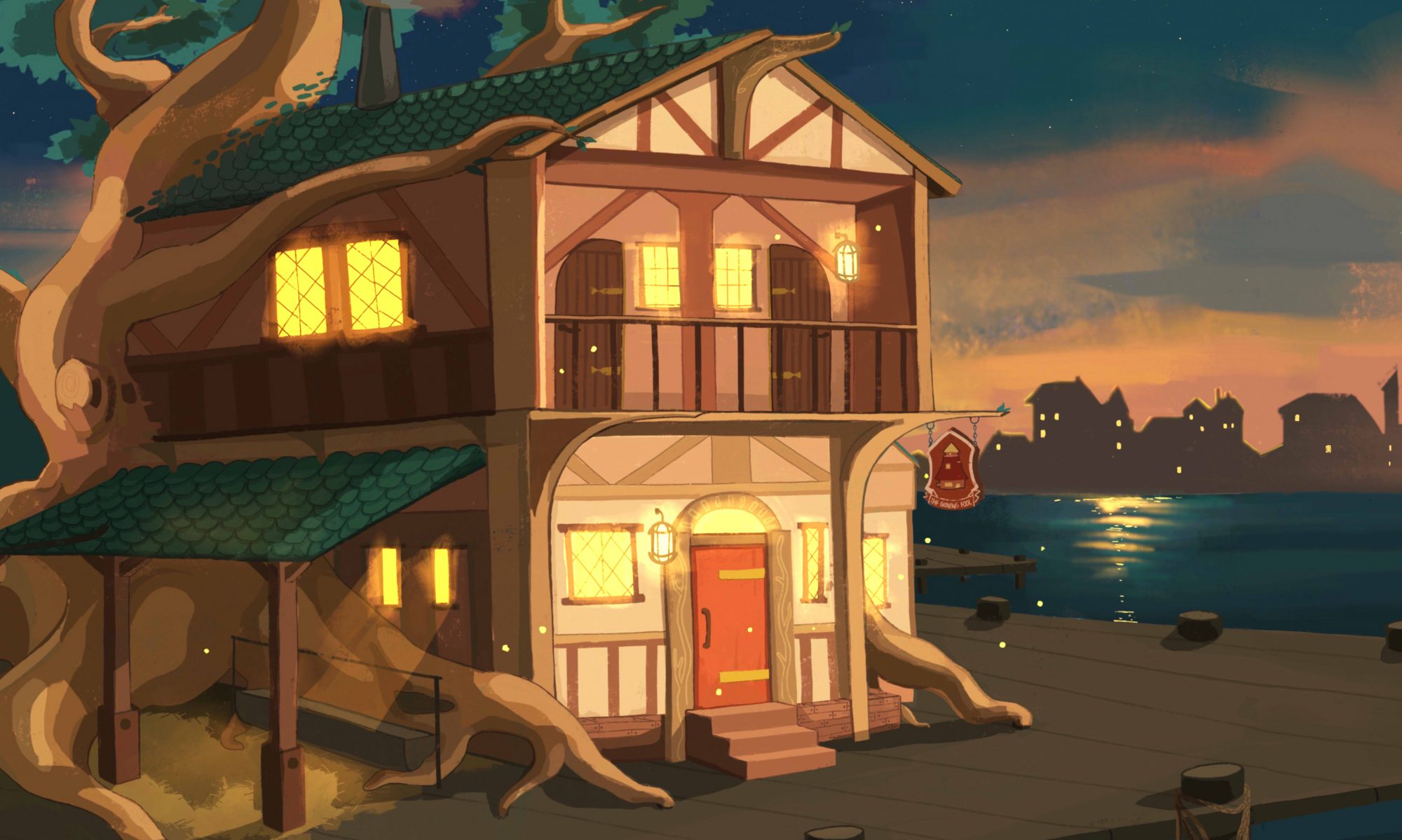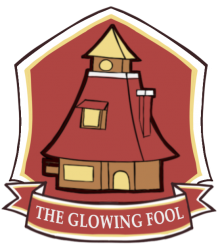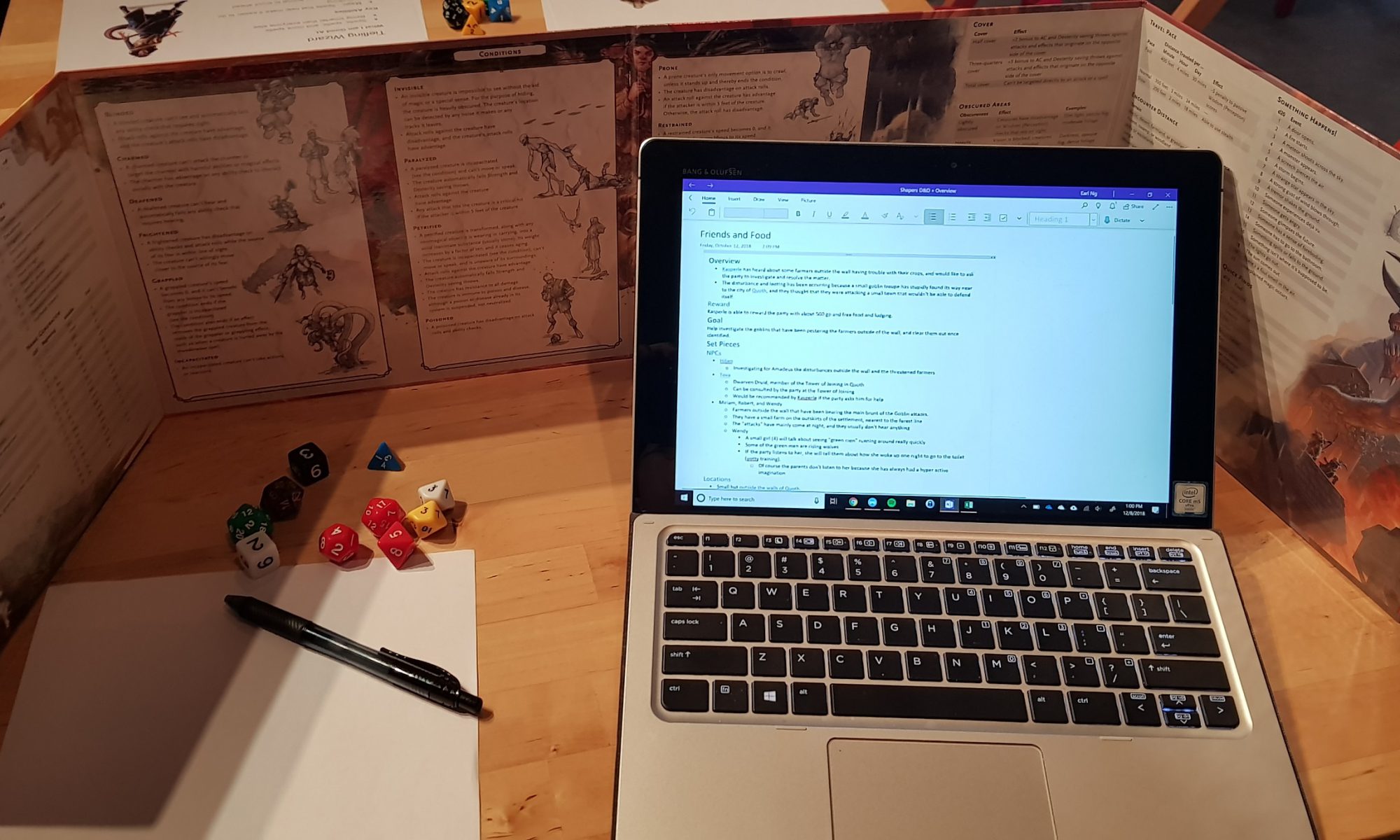It can be quite the challenge being the DM. On top of having to create the entire world, you also have to make sure that you actually remember everything you’ve created. That’s where proper note taking comes in. The hobby of D&D has been described as being one of “aggressive and thorough note-taking.” They’re not far off. As the DM, it is important to be able to prepare your adventure ahead of time for your players, and to do so in a way that will make it easy for you to look up aspects of what you have prepared during the game. Proper note-taking and organization is key to that process. Below we will take a look at the various tools that are available to new DMs for keeping track of their notes, as well as how I personally organize mine.
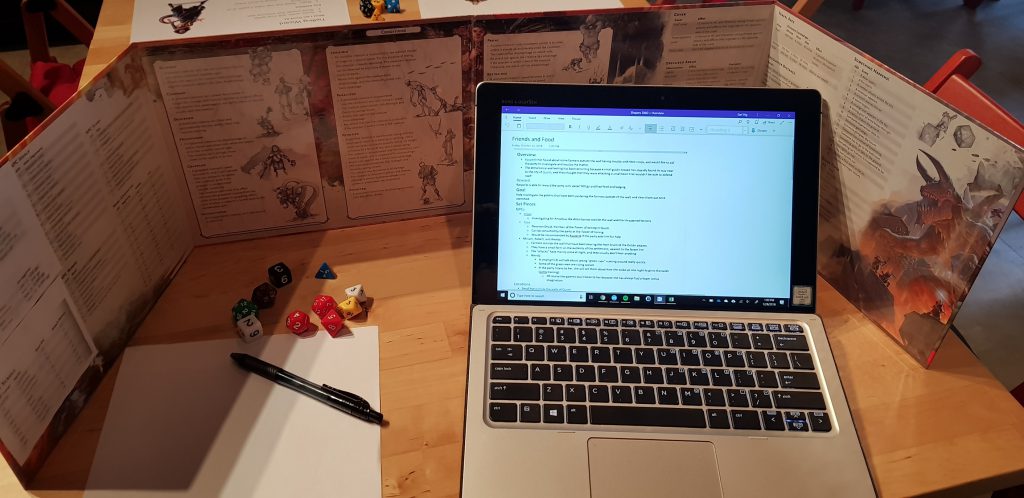
Tools
There are a plethora of note-taking tools available to DMs. The bare minimum requirements for any tool would be to hold text. (even a regular paper notebook would suffice). Everything beyond that (cloud storage, organization, links, searches) is just additional icing on the cake. Some of the more popular options that I have heard about include:
- Microsoft OneNote
- Google Drive
- Microsoft Word
- Microsoft Excel

The primary tool that I use however, is OneNote. I like it over the other options because it has the ability to quickly dividing into different sections and pages, as well as the cloud aspect (for backups and easy access). So below, I will detail how I use OneNote in how I organize my DM Notes for my campaigns:
Arranging Sections
Within my own OneNote files for the games I run, I typically maintain 5 sections:
- Overview
- Locations
- NPCs
- Factions
- Party
I make entries into each of these sections, and liberally link between the different entries in the different sections.
Overview
The overview serves the primary purpose of being the main tab that I have open at any given time. I like to organize my campaigns/games based on the different quests that my players can possibly undertake. So each page in my Overview tab is a separate quest. And in each quest-page, I write down all the details that may be involved in that quest. Typically those sections include:
-
Summary – This would be a quick description of what this quest is all about. What is the hook that attracts the party to it? What is the general idea that you want to accomplish?
- Reward – What does the party get for completing this quest? Gold? Magic items?
- Goal – What is the party’s “win condition”? What do they have to accomplish in order to fulfill the quest and gain the reward?
-
Set Pieces
- NPCs – Who are the notable NPCs that play a major role in this quest? What are their respective goals? Where can the party find them? What information do they have that may be important to the party?
- Locations – What are the important locations that the party will most likely visit during this quest? What do they look like? Are there any traps? You may want to be very very specific about locations, so that it will be easy for you to describe to your players during the game.
- Underlying Plots – Are there any plans or plots that is being pushed by one of the NPCs? Would the party be able to pick up on one of these plots? You can use this for additional world building and depth to add for your players to discover.
- Encounters – List out all of the possible fights that you have planned for your party to encounter. Include the creature stat blocks for easy reference.
As you may have noticed, the majority of the information that I write down on the quest-page relates directly to the quest at hand. However, if there is ever pieces of lore or world building that I have to reference (i.e. the makeup of a major city, an important NPC, or a faction), then I create a link to the relevant page in one of the other sections.
Sample Overview Page: Friends and Food
Additionally, within the Overview tabs, I also maintain a Recaps page, where I summarize everything that my party did for that particular session. It helps with tracking developments within the world, along with the session recaps I do before each new session.
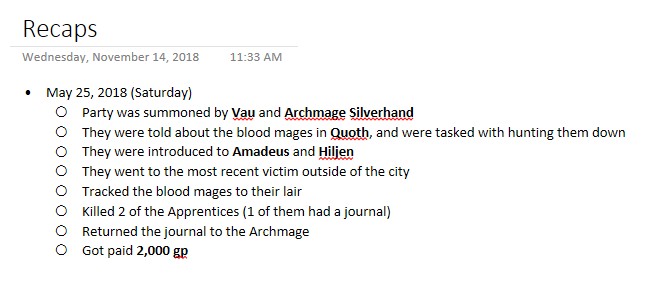
Locations
Right behind the Overview section, the Locations is the second most important tab for the DM to maintain. As the name suggests, each page in the Locations section is a distinct location. Either a City, Town, Dungeon, or small manor out in the woods. Each entry is a distinct geographical place in the DM’s world that they would like to flesh out in more detail. Unlike the other sections, I don’t necessarily have a very detailed skeleton for the location tabs. Typically, after making a brief overview write up on what this place is, what I do is organize each location geographically. So within each location, I break it down further into sub-locations and continue to flesh out the details there.
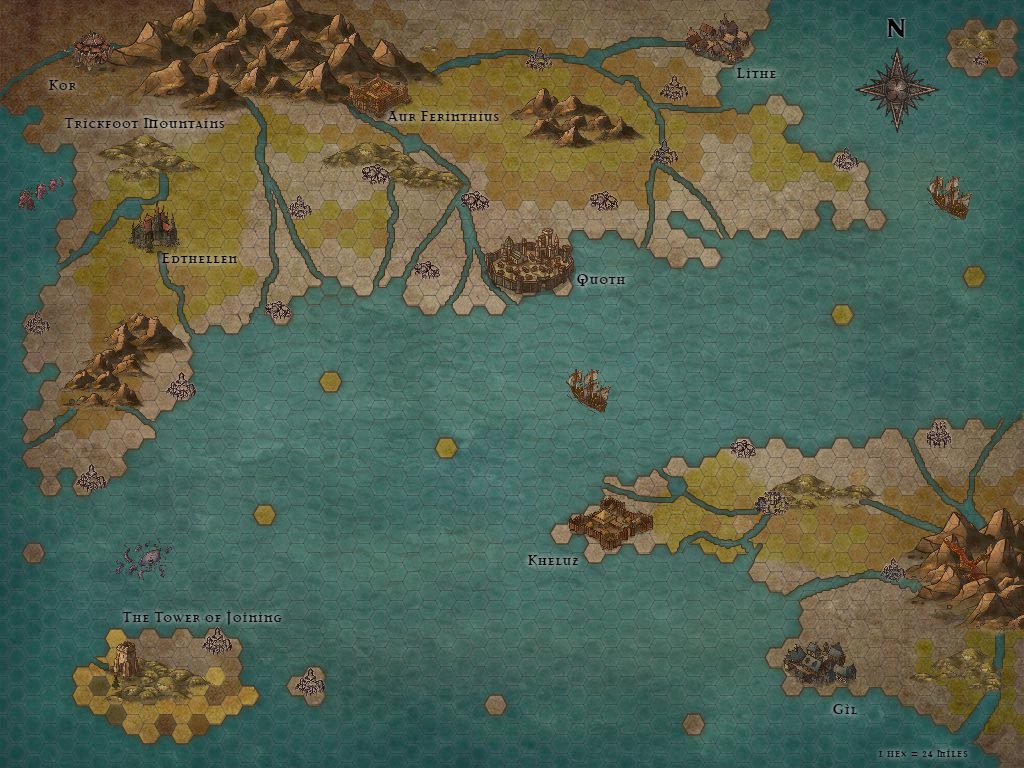
So for example, if I am working on the entry for a major city, I make an entry of what this city is all about, trying to answer questions like:
- What is this city’s purpose? (Is it a trading hub? Political capital? Military outpost?)
- How is this city governed? (Republic? Monarchy? Theocracy? Meritocracy?)
- Who lives in this city? (Population? Demographics?)
After that, I then break the city down into its different wards or quarters. So for a major city, I could break down the city into:

- The Political ward – This is where all the politics and government institutions are
- The Industrial ward – The area where the majority of business and trade is conducted
- The Academia – Where all the academies and schools are (magic or otherwise)
- The Slums – The space that the city’s poor reside
- The Farms – The area that grows the food
The above list is by no means exhaustive, and you can add or subtract as you see fit.
Once my city has been broken up into different sections, I can then go into more detail about what specific places of interest resides in those areas, why they are important, and what they look like.
NPCs
Within the NPC section, I dedicate one whole page to each significant NPC that I think the party will interact with heavily. In each of these pages, I try to detail the following bits of information:
- General Appearance – What does this character look like? Race? Age? General description?
- Position – What does this character do? Is this character a leader or a member of a faction? What resources does this character have at their disposal?
- Abilities – What is this character capable of doing (powers, influence, resources)? Either what they are directly capable of doing, or having others do for them.
-
Goals and Fears
- Goals – What does this character want to achieve? What are they working towards?
- Fears – What is this character afraid of? To what lengths will they go to avoid realizing those fears?
- Personality – How does this character behave? Are they kind? Snobbish? Perpetually angry?
- Relationships – What significant relationships has this character developed? What is the nature of those relationships? Do they have close loved ones? Do they have rivals or enemies?
- History/Backstory – Any specific backstory you would like to have for this character to help further inform the way you role-play this character?
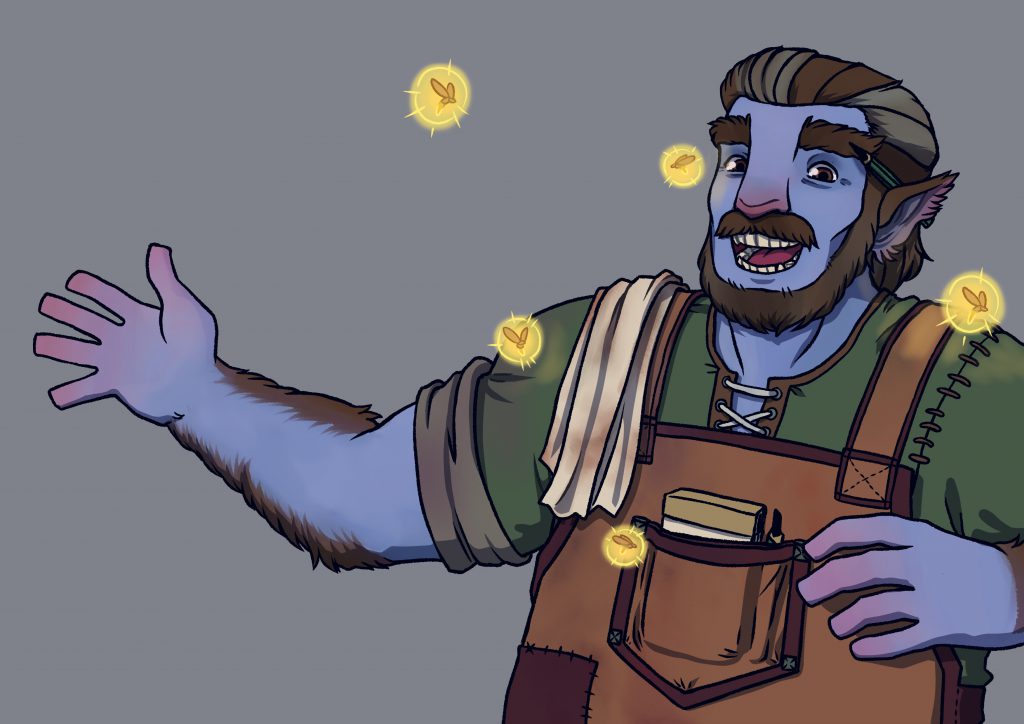
Factions
How I organize my notes for factions is similar to how I organize my information and notes on NPCs. The most important aspects of the factions that I keep particularly close track of are their goals and available resources. Since that informs me of what they will most likely be doing in the world. As well as how the party can potentially interact with the different factions. Keeping track of their goals also makes it easier to figure out how your party could possibly align themselves with certain factions (or make enemies of them). If your players are keen on joining any factions, then it is also probably worth keeping a section on how each faction is organized, and how they like to operate (their modus operandi).
The Party

In this tab, I create one page for each of the PCs that my players have introduced into the game. And here, I primarily keep information such as the backstory that the players have given me about their character, my personal notes about their backstories, and my future plans for how we will dive into, and develop their backstories in the future. Any future plans for backstory-focused quests, I then throw back up to the Overview tab.
I can understand that it may be a bit difficult for one to wrap their mind around how I keep my notes. Hopefully the PDF attachments I’ve provided will help at least give you a better idea of my style. But like all things D&D, there really isn’t a “right” way. There’s just the way that works best for you, so feel free to experiment and see what works and what doesn’t. As always, if you need any help, the Glowing Fool is always happy to provide.
Earl is what you would call a Dungeons & Dragons addict. He watches D&D shows, prowls the D&D forums, and basically lives, breathes, and eats D&D (It’s no joke, he literally listens to the D&D Podcast while eating). He likes to be thought of as the “lead fool” as he guides us all through the silliness of D&D.
For his day-job. Earl is an ERP Consultant with the Nomura Research Institute (NRI). He is also a Shaper with the Global Shapers: Hong Kong Hub.
